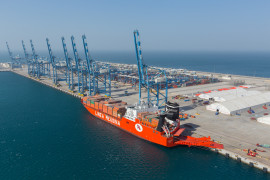
In land-based technologies, India possesses the short-range Prithvi-2 and Agni-1 missiles that are directed towards Pakistan. India also reserves medium-range Agni-2 and intermediate-range Agni-3 that are installed against China, while rail mobile Agni-4 and Agni-5 are stationed against China. In fact, Agni-5 has been built to achieve targets that go beyond China. India is now working on Agni-6 for its MIRVs technologies that certainly suggest Delhi’s power projection aspirations in the broader region.
On the other hand, India’s air-based fighter-bombers remain at the core of its nuclear strike force with a range that extends deep into Pakistan and China. India is also upgrading and extending their service life. It is also simultaneously furthering accuracy of its sea-based second-strike capability, such as ballistic missile submarine (SSBNs) and a ship launch ballistic missile. After building Arihant class nuclear submarine, it is working on another ballistic missile submarine, the Aridhaman, and plans to have four SSBNs in service by 2020. The Arihant will carry the K-15 submarine launched ballistic missiles (SLBM) with combined aspects of both cruise and ballistic missiles. The augmented class of K-15 SLBMs, K-4 has the range of up to 3,500km to hit targets in Pakistan, China and the entire Indian Ocean. India is also working on K-5, SLBM of 5,000km range that raises a set of new questions for its declared minimum deterrence policy that seems no longer credible. More so, Dhanush missile (350km) is a naval version of Prithvi II that gives India a rudimentary sea-based second strike capability.
Moreover, India is working on Nirbhay subsonic ground launched cruise missile which has a range of 700-1,000km designed to be launched from land, air and sea. It has also started thinking of building Hypersonic Glide Vehicles in parallel to MIRV technologies. India has purchased weapons and technologies worth $14 billion over the last decade in order to augment its capabilities to project power in the Asia-Pacific region and has further plans of purchasing six Scorpene-class diesel-electric submarines, and is building a new series of destroyers, frigates and corvettes.
But why is India augmenting these technologies at such a fast pace? One, the US-China competition in the Asia-Pacific creates an environment favourable to India to bolster its technologies and material power in order to play a more assertive role in the entire region. Two, India wants to bridge gaps in its second strike capability. Three, India claims that its modernisation plans are based against the Chinese threat. However, indicators suggest that India is working on capability (maximisation of material power) and not threat based planning. Four, NSG waiver in the backdrop of Indo-US nuclear cooperation has offered India benefits of an NPT state thereby legitimising its access to global commerce to bolster technological base. Five, India advocates that in the event of a conflict with China, India would use sea denial strategies, such as naval blockade to obstruct China’s energy supply line, disrupt its oil and trade lanes in the India Ocean.
What do Indian ballistic tests mean for China? China and India have historic rivalry that goes back to the Sino-Indian war of 1962. Beijing claims the northeast Indian state of Arunachal Pradesh and Delhi does not recognise Beijing’s jurisdiction over Aksai Chin in southwest China. Both also claim a small part of Kashmir. These differences have remained inaudible for many years. In recent years, India’s ‘Look East’ policy has revived some of these issues. India is in intense competition with China to achieve everything that China has attained and hence, while China views the US as a hegemonic power in the Asian region that aims at containing its rise, it views India as hedging against it too. Resultantly, China-India territorial rivalries are regaining pace.
The Doklam incident, however, was a self-created event by India to justify its military modernisation plans. Despite this rivalry, the trade volume between the two states is rising incredibly, going over $100 billion on a yearly basis. China is a continental power with the ability to resolve many of its border conflicts with its neighbouring countries, and it would continue to avoid a conflict with India. And India too is not preparing to fight a serious war with its regional neighbour. At present China’s economy and defence budget are four to five times larger than India’s. But despite that China poses no threat to India, and claims that it is only modernising its defence system, such as the BMD technologies, ballistic missiles and supersonic technology, including A2/AD platforms, to safeguard its economic and security interests in the Asia-Pacific region.
In the wake of these developments, it becomes relevant to identify what impact would these technologies have on Pakistan. India’s rapid growth of its defence arsenals, evolving sophisticated technologies, possible revision of its doctrines create enormous stability challenges that compel Pakistan to modernise its own technologies. Indian action are forcing Pakistan into a serious arms race, destabilising regional deterrence and promoting the probability of war. India would continue to avoid negotiations with Pakistan as India regards negotiations as a sign of weakness. These trends suggest deepening security dilemma between India and Pakistan leading to increased risks of war in the absence of dialogue and restraint regime. Considering that these trends would yield serious challenges, it is important for Pakistan to devise a stability mechanism with budgetary constraints before it is too late.
Published in The Express Tribune, March 2nd, 2018.
Like Opinion & Editorial on Facebook, follow @ETOpEd on Twitter to receive all updates on all our daily pieces.



































1713853507-0/MalalaHilary-(2)1713853507-0-270x192.webp)








COMMENTS (10)
Comments are moderated and generally will be posted if they are on-topic and not abusive.
For more information, please see our Comments FAQ